By Fred Manzo
Labyrinth: The War on Terror 2001-?
Overview
This guide is not a substitute for reading the full rules. It is an outline of the game’s core concepts.
All Labyrinth rules are divided into three parts: those that involved both players, those that involve the US player and those that involve the Jihadist player.
Both Players
Players may use either the Event or the Ops Points on any card that is associated with their position or is not associated with their opponent’s. Players may use two cards at a time. The Jihadist player goes first each turn.
Players may also use the Ops Points of any card they are dealt that is associated with their opponent’s position. This, however, will also trigger their opponent’s Event.
Card Events must meet prerequisites first, then they are resolved line by line, with a sentence that does not apply being skipped.
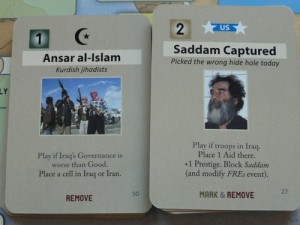 All dealt cards must be used by both players (except that one card may be saved or discarded by the US player each turn and one US event need not be trigger by the Jihadist player each turn when its card is placing in the First Plot box).
All dealt cards must be used by both players (except that one card may be saved or discarded by the US player each turn and one US event need not be trigger by the Jihadist player each turn when its card is placing in the First Plot box).
Victory conditions are judged instantaneously.
US Player
The US Player monitors 3 charts: the U.S. Troop Track, the US Global War on Terror (GWoT) Relations Track and the US Prestige Track.
The Troop Track holds troops ready for deployment. The more troops that are deployed from this Track, the fewer cards the US player will receive next turn.
The US GWOT Relations track records the US and the World’s posture. When they disagree there is a sliding scale of negative DRMs to any US War of Ideas operation.
The Prestige track follows the flow of U.S. Prestige: Low prestige generates a negative DRM and high prestige generates a positive DRM during U.S. War of Ideas operations.
The US usually gets its way. But it must pay for its actions in Operations Points (Ops). The cost is equal to the Governance level of the targeted country. However, the US player may not split the use of its Ops Points between different countries or operations. The purpose of US War of Ideas operations is to change the Governance (e.g. improve from Poor to Fair) or Alignment (e.g. from Neutral to Ally) of Muslim countries, or to change the Posture (e.g. from Soft to Hard or vice-versa) of non-Muslim countries.
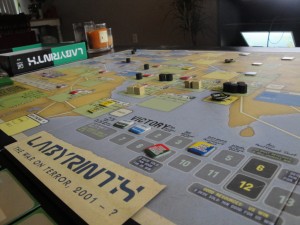 The US has two possible Postures: Hard and Soft. A Hard posture allows the U.S. to execute Regime Change (RC) operations; a Soft posture allows US Troops to Withdraw from a Regime Change situation that perhaps is not going so well (i.e. the liklihood of improving the country to ”Good Governance” is slim). It is easier to maintain world support when the US posture is Soft, because the other non-Muslim countries of the world have a bias toward Soft Posture. A Soft Posture allows a number of US events to be triggered. Non-Muslims countries also have a Soft or Hard Posture. A Hard posture allows them to Disrupt Jihadist Cells in their country more effectively than when in a Soft posture. The Posture of a country also affects the US GWoT Relations Track.
The US has two possible Postures: Hard and Soft. A Hard posture allows the U.S. to execute Regime Change (RC) operations; a Soft posture allows US Troops to Withdraw from a Regime Change situation that perhaps is not going so well (i.e. the liklihood of improving the country to ”Good Governance” is slim). It is easier to maintain world support when the US posture is Soft, because the other non-Muslim countries of the world have a bias toward Soft Posture. A Soft Posture allows a number of US events to be triggered. Non-Muslims countries also have a Soft or Hard Posture. A Hard posture allows them to Disrupt Jihadist Cells in their country more effectively than when in a Soft posture. The Posture of a country also affects the US GWoT Relations Track.
The US may Reassess its own Posture. That is, change its Posture from Soft to Hard or from Hard to Soft (it costs two 3 Ops cards in the same US turn to do this).
With a 1 Ops card, the US may perform an operation in a Good Governance country or may increase its Reserve Ops Points by one.
With a 2 Ops card, the US may perform an operation in a Fair or Good Governance country or may increase its Reserve Ops Points by two.
With a 3 Ops card, the US may Alert against a Plot (foil a plot), or perform an operation in a Poor, Fair or Good Governance Muslim country. It allows the US to execute a War of Ideas operation in any Muslim country that is not under Islamist Rule, or in any non-Muslim country. It also allows the US to launch a Regime Change operation against an Islamist Rule country (if US Troops are available.)
The US player may Deploy troops to a Muslim Ally or back to the Troop Track (this can’t involve troops under a RC marker, since they are considered “locked in” to the Regime Change situation). Only an Event Card play or a Regime Change operation may alter the Alignment of an Islamist Rule country. Only card Events can affect an Adversary country.
The US may also conduct a Disrupt operation, which activates a Sleeper cell or moves an Active cell back to the Jihadist Funding track. Normally, one cell at a time is affected by a Disrupt operation, but 2 cells may be affected at a time when the target country’s Posture is Hard or there are two or more US Troops in a Muslim country.
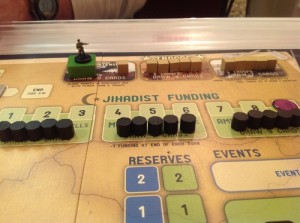 It is easy to change an Islamist Rule country to US Ally by conducting a RC (Regime Change) Operation, but difficult to withdraw the US troops afterwards. To do so, the US must either change its posture to Soft and withdraw its troops or stay in a Hard posture and improve the country’s Governance level to Good. Both are expensive.
It is easy to change an Islamist Rule country to US Ally by conducting a RC (Regime Change) Operation, but difficult to withdraw the US troops afterwards. To do so, the US must either change its posture to Soft and withdraw its troops or stay in a Hard posture and improve the country’s Governance level to Good. Both are expensive.
The first priority of the US player is to get his troops out of a Regime Change country. He also wants to defend Pakistan, foil as many plots as possible and lower the Jihadist Funding level, even if it doesn’t permanently depress Jihadist income. (Other players may have their own ideas of US strategy and priorities)
Jihadist Player
The Jihadist player must monitor his Funding track. The more funding a Jihadist player obtains, the greater the number of cell that may be recruited off this track to the map and the greater the number of cards he receives next turn.
Cells may place Plots, Recruit more Cells, generate Minor Jihad operations, Major Jihad operations or simply Travel. The Jihadist player may also increase his Reserves by one or two Ops Points or clear out his Reserve Ops. Jihadist operations are not automatically successful. For each operation the Jihadist player must roll a die number less than or equal to the Governance value of the target country (for “Good Governance” countries, he must roll a 1 or less; for “Fair” countries, 2 or less, and for “Poor” countries, 3 or less). So you can see the worse the country’s Governance, the easier it is for the Jihadists to operate within it. Muslim countries Governance levels can be affected by players (improved or degraded), but non-Muslim countries Governance levels are fixed and printed on the game map. A non-Muslim country’s Recruit number, which is also printed on the map, supersedes its Governance number for purposes of Recruiting only. Normally a Jihadist Cell must be already present in a country to allow the Jihadist player to Recruit there, but the presence of a Jihadist Cadre marker also allows Recruiting.
Cells may Travel anywhere on the board after rolling against the target country’s level of Governance, but they may automatically Travel to adjacent countries or Travel inside a country in order to turn an Active Cell back into a Sleeper Cell. Failure in Traveling returns cells to the Jihadist Funding track. The Jihadist player is automatically successful in Recruiting and Traveling cells from the Funding track into any Islamist Rule or a Regime Change country. However, it still requires the expenditure of one Ops Point to travel one cell.
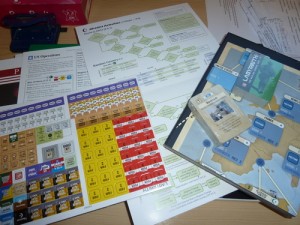 The Jihadist may split operations between various countries. Only one type of operation at a time may be conducted, however (i.e. can’t do “Recruit” operation in Yemen and a Travel operation to Somalia with the same card). Failed rolls generally cause the removal of Cells to the Funding track (exception: Failed Plots do not cause Cell removal, but they force the Cell to go “active” thus making it more vulnerable to US Disrupt operations).
The Jihadist may split operations between various countries. Only one type of operation at a time may be conducted, however (i.e. can’t do “Recruit” operation in Yemen and a Travel operation to Somalia with the same card). Failed rolls generally cause the removal of Cells to the Funding track (exception: Failed Plots do not cause Cell removal, but they force the Cell to go “active” thus making it more vulnerable to US Disrupt operations).
Plots may increase Jihadist funding, lower US Prestige (if US troops are present) or win the game (if WMD are set off in the US). Unblocked Plots in Schengen countries (mainly EU countries) allow Posture rolls in three countries, which can affect the GWoT scale. Plots must be triggered to have any effect and they may be blocked by the US play of a 3 Ops card as an Alert operation.
A successful Minor Jihad removes an Aid marker and lowers a country’s governance level one level for each successful roll, but not to Islamist Rule status. A failed roll moves a cell back to the Funding Track.
A successful Major Jihad allows a Poor country to shift to an Islamist Rule country (one of the conditions for victory). There must be 5 more cells than US troops in a country to attempt a Major Jihad. Two successful rolls on one Event Card worsen the Governance level from Poor to Islamist Rule. If you roll three dice for the Major Jihad and fail, the Poor country shifts its Alignment towards Ally (in other words, the Jihad attempt backfires, causing the government to move closer to the US). Also a Besieged Regime marker is placed, making future Jihad attempts easier. Having an Islamist Rule country at a turn’s end also lowers US prestige. Only events and Regime Changes affect an Islamist Rule country.
Every unmarked Muslim country a Cell enters must be Tested to determine its initial Governance of Poor or Fair (Good Governance is never possible on the initial testing roll). The initial Alignment is always set to Neutral. Every unmarked non-Muslim country a Cell enters must be Tested for initial Posture, either Soft or Hard.
The Jihadist player may degrade the Alignment of a US Muslim Ally only through play of Card Events.
The first priority of the Jihadist player is to convert Pakistan to Islamist Rule. He also wants to degrade the level of Governance of as many countries as possible. Although triggering Plots is also important, as it may lower US Prestige, increase Jihadist Funding and shift world opinion against the US. (Other players may have their own ideas of Jihadist strategy and priorities)
 Labyrinth Rules
Labyrinth Rules


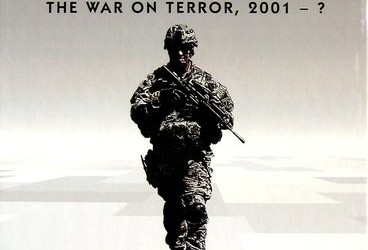
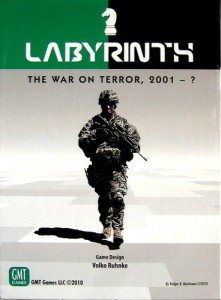
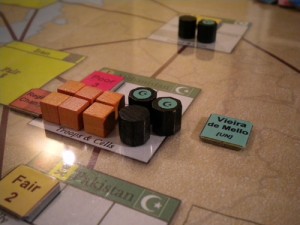
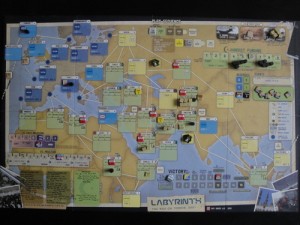






You say that the US can remove troops from a regime change country ” the US must either change its posture to Soft and withdraw its troops or stay in a Hard posture and improve the country’s Governance level to Good. Both are expensive.” I get the first, but where do the rules say changing governance to good has any effect on troop removal?
Thanks
Hi:
Thanks for submitting the comment. I believe the answer to your question is that you can take troops out by withdrawing as per 7.3.5. This, however, requires a “Soft Posture” and troops in a “Regime change” country. The only other way to get troops out is to Deploy troops at your discretion from any country that does not have a “Regime Charge” marker.
But to Deploy troops out of a “Regime Change” country you need to end up with 5 more troops than cells. So to get those last 5 + troops out of a “Regime Change” country you need to remove the “Regime Change” marker, which means upgrading it to a “Good Governance” country (rule 7.3.4.1) so it’s no longer a “Regime change” country.
See
Rule 7.3.1 (Exception)
Rule 7.3.4.1
Rule 7.3.5
– Fred
As we haven’t played this game in a number of years I double checked my understanding with Dr. Harvey Mossman, who is an expert on this particular game (as he is with many others). His answer is:
Fred,
It’s been a long time since I played the game. The answer is that once the Regime Change marker is removed, troops can freely deploy in AND OUT of the country. Getting to Good Governance (or Islamist Rule) removes the Regime Change marker. So your answer is correct. I think, if I interpret his question correctly, he is missing the fact that the Regime change marker gets removed when you get the country to Good Governance. Once that marker is removed the US can freely Deploy in and out of the country without restriction.
Harv